Monthly Archives: November 2021
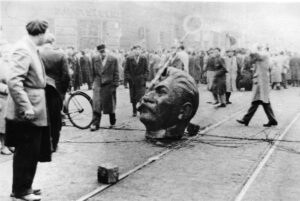 Those who support Socialism, Marxism, and Communism have simply never lived under these forms of government, or they are a part of the upper echelon of such a government. People who have been forced to live under these types of government, will ultimately try to find a way of escape or will participate in a national uprising, such as the one that happened in Hungary in 1956.
Those who support Socialism, Marxism, and Communism have simply never lived under these forms of government, or they are a part of the upper echelon of such a government. People who have been forced to live under these types of government, will ultimately try to find a way of escape or will participate in a national uprising, such as the one that happened in Hungary in 1956.
Sadly, by the time the people realize that they are in serious trouble, the government often has such a chokehold on the nation that the only way out if to have an uprising. Nevertheless, people will eventually fight for their rights, or fight to escape. While the uprising in Hungary began in October 1956, when thousands of protesters took to the streets demanding a more democratic political system and freedom from Soviet oppression, the real problem started long before that. It started when the Communist Party took over and began to systematically take away the rights of the people. There were a few people within the party who could see through the Communist Party’s ideas. When party officials appointed Imre Nagy, a former premier who had been dismissed from the party for his criticisms of Stalinist policies, as the new premier, he began to try to restore peace and asked the Soviets to withdraw their troops. The Soviets did so, but Nagy then tried to push the Hungarian revolt forward by abolishing one-party rule. He also announced that Hungary was withdrawing from the Warsaw Pact (the Soviet bloc’s equivalent of NATO).
This forced the hand of the Soviet government. On November 4, 1956, Soviet tanks rolled into Budapest to 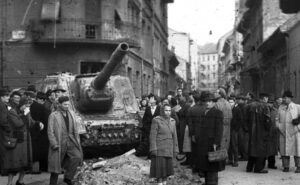 crush the national uprising, once and for all. Te fighting in the streets was vicious, but the Soviets’ greater power ensured their victory. The people had long been stripped of their weapons, and anything else that might have helped the achieve victory. At 5:20am Hungarian Prime Minister Imre Nagy announced the invasion to the nation in a grim, 35-second broadcast, declaring: “Our troops are fighting. The Government is in place.” He tried to reassure the people and keep hope alive, but within hours, Nagy sought asylum at the Yugoslav Embassy in Budapest. He was captured shortly thereafter and executed two years later. Nagy’s former colleague and imminent replacement, János Kádár, who had been flown secretly from Moscow to the city of Szolnok, 60 miles southeast of the capital, prepared to take power with Moscow’s backing. The conspiracy was complete, and the people had been betrayed…even their leader.
crush the national uprising, once and for all. Te fighting in the streets was vicious, but the Soviets’ greater power ensured their victory. The people had long been stripped of their weapons, and anything else that might have helped the achieve victory. At 5:20am Hungarian Prime Minister Imre Nagy announced the invasion to the nation in a grim, 35-second broadcast, declaring: “Our troops are fighting. The Government is in place.” He tried to reassure the people and keep hope alive, but within hours, Nagy sought asylum at the Yugoslav Embassy in Budapest. He was captured shortly thereafter and executed two years later. Nagy’s former colleague and imminent replacement, János Kádár, who had been flown secretly from Moscow to the city of Szolnok, 60 miles southeast of the capital, prepared to take power with Moscow’s backing. The conspiracy was complete, and the people had been betrayed…even their leader.
The people of the West were stunned by the Soviet action. Soviet leader Nikita Khrushchev had promised to retreat from the Stalinist policies and repression of the past, but the violent actions in Budapest told of a different plan. An out of control government will always chose its own greedy ways over the good of the people it is supposed to serve. On that day, an estimated 2,500 Hungarians died and 200,000 more fled as refugees. Sporadic armed resistance, strikes, and mass arrests continued for months thereafter, causing substantial economic disruption. The spontaneous national uprising that began 12 days before in Hungary was viciously crushed by Soviet tanks and troops on November 4, 1956.
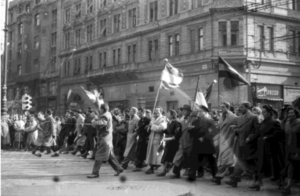
Many Hungarians were angered and frustrated by the inaction on the part of the United States. Voice of America radio broadcasts and speeches by President Dwight D Eisenhower and Secretary of State John Foster Dulles had recently suggested that the United States supported the “liberation” of “captive peoples” in communist nations, but they didn’t see that playing out in their situation. During that time, approximately 30,000 Hungarian refugees were allowed to enter the United States. Yet, as Soviet tanks bore down on the protesters, the United States did nothing beyond issuing public statements of sympathy for their plight.
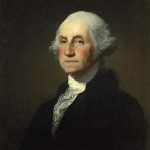 Politics is always a dirty game. That is probably why most of us don’t like career politicians. They will do or say anything to win or further their careers. “Dirty politics” has been around as long as there have been politicians…and politics isn’t even limited to just politicians. There’s office politics, military politics, law enforcement politics, and more.
Politics is always a dirty game. That is probably why most of us don’t like career politicians. They will do or say anything to win or further their careers. “Dirty politics” has been around as long as there have been politicians…and politics isn’t even limited to just politicians. There’s office politics, military politics, law enforcement politics, and more.
General George Washington wasn’t even exempt. In October 1777, while serving as the commander of the Continental Army, Washington was informed of a conspiracy to discredit him with Congress and have him replaced by General Horatio Gates. The loosely organized attempt was supposedly led by Brigadier General Thomas Conway, who was an Irish member of the French army. Conway commanded a brigade in Washington’s army, and he was unhappy with Washington’s performance in the Battle of Brandywine. Conway was also bragging about his own feats at the same operation. Conway was even so bold as to request a promotion for himself, to the rank of major general…based on the merits of his “performance” in the battle. Washington protested Conway’s promotion and was irritated by the request, believing it would have disastrous effects on the morale of more senior officers. I think the biggest problem was the arrogance of Conway. It just isn’t right to brag on yourslf so much.
Thomas Conway, would be made inspector general of the United States less than two months later on December 14, but it is my belief that it was in an effort to pigeon-hole hime, because he was an embarrassment. Conway, was born in Ireland, but raised in France. He entered the French army in 1749. Silas Deane, the American ambassador to France, recruited Conway to the Patriot cause. Conway met with Washington at Morristown in May 1777, after which, he was appointed brigadier general and assigned to Major General John Sullivan’s division. Conway served admirably under Sullivan at the battles of Brandywine, in September 1777, and Germantown, in October 1777, before becoming involved in an unconfirmed conspiracy to remove General Washington from command of the Continental Army. It ruined his military career.
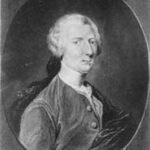
Conway wasn’t alone in the cabal. The Continental Army had suffered several defeats in the fall of 1777, and some members of Congress felt it was Washington’s leadership that was to blame. Conway began writing letters to prominent leaders, including General Horatio Gates, that were critical of Washington. After Washington got wind of Conway’s letter to General Gates, he wrote his own letter to Congress in January 1778. Conway was embarrassed, and in March 1778, he offered his resignation as an apology. Nevertheless, he was surprised and humiliated when Congress accepted. After General John Cadwalader wounded him in a duel defending Washington’s honor, Conway returned to France, where he died in exile in 1800…unable to recover his dignity after the horrific Conway Cabal.
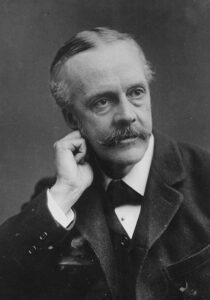 For a number of years Israel had no place to call home. That sounds like a strange thing, but for the nation of Israel, it was not a new thing. Biblical history tells us of a number of times that Israel’s God-given land was taken from them for a time, and they were taken into captivity. Even after the captivity the Jewish people were displaced from their promised land. They were also persecuted and subject to racial discrimination.
For a number of years Israel had no place to call home. That sounds like a strange thing, but for the nation of Israel, it was not a new thing. Biblical history tells us of a number of times that Israel’s God-given land was taken from them for a time, and they were taken into captivity. Even after the captivity the Jewish people were displaced from their promised land. They were also persecuted and subject to racial discrimination.
That began to change when on November 2, 1917, Foreign Secretary Arthur James Balfour wrote an important letter to Britain’s most illustrious Jewish citizen, Baron Lionel Walter Rothschild, expressing the British government’s support for a Jewish homeland in Palestine. I can only imagine how the Baron felt. This was like having someone offer you the moon. It was something the Jew never thought they would see again. Many didn’t think they would live long enough to see it. The letter would eventually become known as the Balfour Declaration, and it was the start of something good.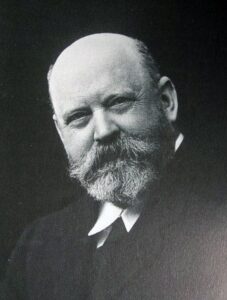
Because of concerns over the direction World War I was going, the British were very supportive of the Zionist movement. Lloyd George among others, held a genuine belief in the righteousness of Zionism, but Britain’s leaders also hoped that a statement supporting Zionism would help gain Jewish support for the Allies. On November 2, Balfour sent his letter to Baron Rothschild, who was a prominent Zionist and a friend of Chaim Weizmann, stating that: “His Majesty’s Government view with favor the establishment in Palestine of a national home for the Jewish people.”
The influence of the Balfour Declaration on the course of post-war events was immediate: According to the “mandate” system created by the Versailles Treaty of 1919, Britain was entrusted with the administration of Palestine, with the understanding that it would work on behalf of both its Jewish and Arab inhabitants. In 1948, the Balfour Declaration was scheduled to expire and Great Britain would no longer rule Palestine. The future of the Jewish people was at stake. The question over what to do with the 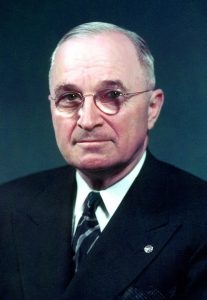 turbulent country was turned over to the United Nations. They, at the insistence of President Harry Truman, eventually decided to create the new country of Israel, specifically as a promised homeland for Jewish people. The new country was to be located across the various holy locations in which many events of the Old Testament occurred. The Jewish people were back in the promised land.
turbulent country was turned over to the United Nations. They, at the insistence of President Harry Truman, eventually decided to create the new country of Israel, specifically as a promised homeland for Jewish people. The new country was to be located across the various holy locations in which many events of the Old Testament occurred. The Jewish people were back in the promised land.
That was when United States President Harry Truman became the first world leader to officially recognize Israel as a legitimate Jewish state. On May 14, 1948, only eleven minutes after its creation the decree was delivered. His decision came after much discussion and advice from the White House staff, all of whom had differing viewpoints. Some advisors felt that creating a Jewish state was the only proper response to the Holocaust and would benefit American interests. Others took the opposite view, concerned about that the creation of a Jewish state would create more conflict in an already tumultuous region. No matter what happens, it was the right thing to do.
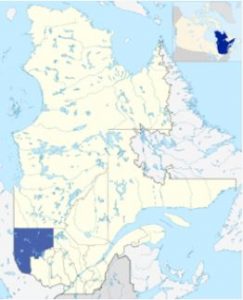 I suppose that if I lived in Quebec, Canada, I might have heard the Abitibi-Témiscamingue region and maybe even the Western Quebec Seismic Zone. Since I don’t, these areas are new to me. Maybe they were new to a lot of people, but on November 1, 1935, a lot more people knew about them. On that day, a 6.1 magnitude earthquake with a maximum Mercalli intensity of VII (Very strong) occurred. The epicenter occurred on a thrust fault in the Timiskaming Graben, a little over 6 miles northeast of Témiscamingue, at about 1:03am ET.
I suppose that if I lived in Quebec, Canada, I might have heard the Abitibi-Témiscamingue region and maybe even the Western Quebec Seismic Zone. Since I don’t, these areas are new to me. Maybe they were new to a lot of people, but on November 1, 1935, a lot more people knew about them. On that day, a 6.1 magnitude earthquake with a maximum Mercalli intensity of VII (Very strong) occurred. The epicenter occurred on a thrust fault in the Timiskaming Graben, a little over 6 miles northeast of Témiscamingue, at about 1:03am ET.
While the earthquake was in Canada, it was felt over a wide area of North America, extending west to Fort William (now Thunder Bay), east to Fredericton, New Brunswick, north to James Bay and south as far as Kentucky and West Virginia. Occasional aftershocks were reported for several months. That seems extreme for a 6.1 magnitude earthquake, but I suppose it’s all in the connections. Fault lines aren’t just in a small area, they run for hundreds and even thousands of miles.
The most significant damage from the earthquake, both in the immediate area and as far south as North Bay and Mattawa, was to chimneys. In fact, 80% of the chimneys in that area were destroyed. A railroad embankment near Parent, which is 186 miles away, also collapsed. It looked like the embankment slide was already imminent, but the quake vibrated the last holds loose. There were some rockfalls and structural cracks reported as well. Thankfully, there were few major structural collapses aside from the Parent embankment. The 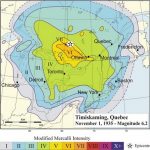
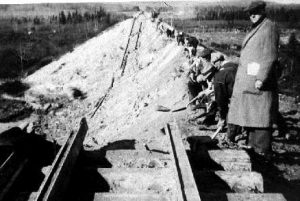 sparseness of the area’s population played a big part in the relative lack of major damage, despite the fact that it was a strong earthquake. The water of Tee Lake, close to the epicenter was discolored by the earthquake…due to a stirring up of gyttja, which is freshwater mud with abundant organic matter, rather than silt input from tributary streams. The relative lack of major damage, despite the fact that it was a strong earthquake, has been attributed primarily to the sparseness of the area’s population.
sparseness of the area’s population played a big part in the relative lack of major damage, despite the fact that it was a strong earthquake. The water of Tee Lake, close to the epicenter was discolored by the earthquake…due to a stirring up of gyttja, which is freshwater mud with abundant organic matter, rather than silt input from tributary streams. The relative lack of major damage, despite the fact that it was a strong earthquake, has been attributed primarily to the sparseness of the area’s population.

